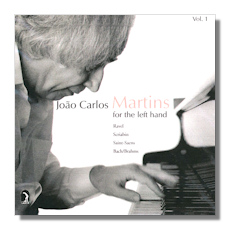
The Internet's Premier Classical Music Source
Related Links
-
Brahms Reviews
Ravel Reviews
Saint-Saëns Reviews
Scriabin Reviews - Latest Reviews
- More Reviews
-
By Composer
-
Collections
DVD & Blu-ray
Books
Concert Reviews
Articles/Interviews
Software
Audio
Search Amazon
Recommended Links
Site News
 CD Review
CD Review
João Carlos Martins

For the Left Hand, Volume 1
- Maurice Ravel: Concerto for Piano Left Hand in D Major
- Alexander Scriabin: Nocturne, Op. 9, #2
- Camille Saint-Saëns: Six Études, Op. 135, #1
- Johannes Brahms: Chaconne (Bach Study #5)
João Carlos Martins, piano
Bulgarian National Symphony Orchestra/Boris Spassov
Labor LAB7033-2 DDD 58:42
As the saying goes, when life gives you lemons, make lemonade. Brazilian pianist João Carlos Martins has been plagued by injuries, accidents, and illnesses; still he keeps on playing. Most recently, he lost the use of his right hand, but instead of throwing in the towel, Martins has taken on the piano repertoire for the left hand only. This is the first volume of "João Carlos Martins for the left hand."
Ravel's concerto probably is the most famous work written for one hand only. It, like so many left-hand works, was written for pianist Paul Wittgenstein, who had lost his right arm during World War One. Much of the time, it's hard to believe that just one hand is playing. Martins and the Bulgarian orchestra are by no means idiomatic in this concerto – Martins alternately seems to be picking and thrashing his way through thickets of notes, and the orchestra plays with a savagery quite unexpected for Ravel. Nevertheless, you'll never hear another performance of this concerto quite like the present one, so if this music is dearto your heart, don't miss this brave and daringly uncivilized performance of it.
At one time, Martins downplayed his ability to play sustained, legato music effectively. Well, to merge two old phrases, necessity makes strange bedfellows. At one time, the Scriabin Nocturne would have been odd repertoire for the pianist. Martins plays it songfully but emphatically – again, not in a manner that I would call idiomatic, yet there's a compellingly defiant quality to this pianism. The six Saint-Saëns études are not remarkable music; even so, they are effective occasional pieces. Some of them are neo-Classical, even neo-Baroque in style, and the dryness of these pieces in particular suits Martins well.
It was inevitable that Martins – one of this era's greatest Bach players – would now record Johannes Brahms' transcription of the famous Bach Chaconne. (Brahms told Clara Schumann he could enjoy performing this work only by playing it with the left hand – doing so helped him to understand the technical difficulties faced by the solo violinist in Bach's original.) This is a fitting end to the CD, and also a moving one. All the virtues of Martins's Bach pianism – crispness, clarity, and communication – are evident here.
These recordings were made in June 2001 in Sofia. The piano sound is detailed, but more attractive in the Ravel than in the solo recordings. Labor promises that Martins's new recording of works by Haydn and Mozart will be released this year.
Copyright © 2002, Raymond Tuttle



















